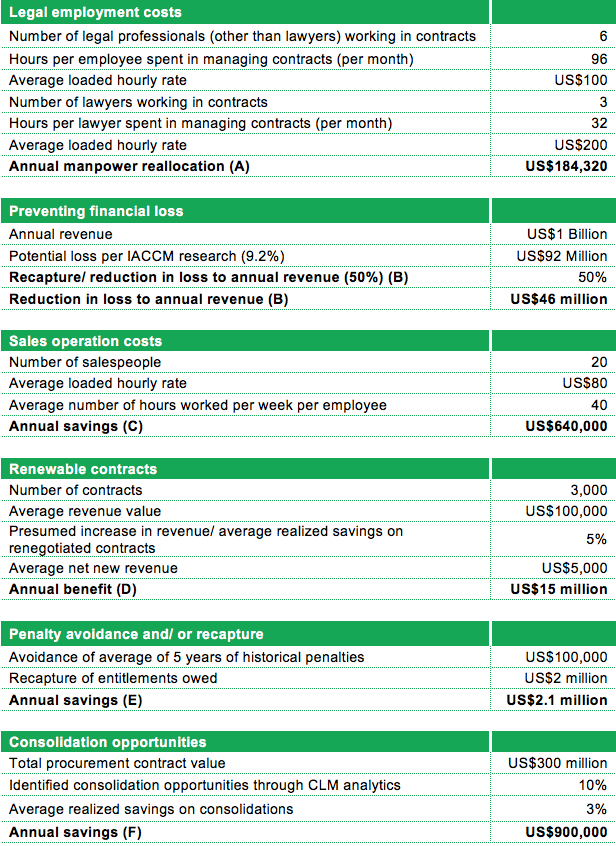
Recent innovations in Contract Lifecycle Management (CLM) software have paved the way for new and exciting opportunities for businesses to become more effective, efficient, and profitable in their work. Among other advances, artificial intelligence (AI) has opened the door to new methods to author, store, analyze, and manage contracts.
But technological advances are only part of the story about how CLM software is changing our relationship to legal work. Now, CLM technology not only allows for a more efficient contract management process, but can also demonstrate an ROI before a company adopts it. Historically, the decision to adopt CLM technology has required a leap of faith: Will engaging this tool provide a good ROI?
To answer this question, CLM software leader Ultria has created a free, data-driven ROI calculator. With this novel tool, interested parties can build a business case for using CLM software, and potentially an opportunity to redefine their role to one as a revenue generator, as opposed to a cost center.
Ultria’s approach to proving the value of their product is straightforward. For years, top consulting and investment firms have published research on the impact of CLM software. Ultria has gathered the top research, cross-referenced it with their own experience in the industry, and created a calculator based on empirical, proven assumptions.
The tool identifies the reduction of expenses and addition of benefits in six areas, drawing from reports at organizations like Goldman Sachs and the International Association for Contract and Commerical Management (IACCM). This information is coupled with the expertise and experience from Ultria’s analysts to project the net benefit of using CLM software in these categories:
Legal employee costs
Tools that automate work, predictably, reduce the amount of time needed to complete tasks related to creating new contracts. The impact has been found to be profound: Goldman Sachs has determined that using a CLM reduces the average hours spent on contracts by 20 percent. When that time is recaptured from every lawyer, paralegal, and other staff member managing contracts, it has the potential to significantly impact an organization’s bottom line.
Preventing financial loss
The use of CLM does not only reduce labor costs, but it also increases revenue that would otherwise be lost due to poor entitlement management and weak obligation compliance. IACCM has found this figure to account for more than nine percent of revenue.
Sales operations costs
An organization’s sales cycle is directly affected by embedded inefficiencies in contract management, which, in turn, translates into wasted resources. According to research conducted by the Aberdeen Group, CLM usage results in 24 percent reduction in sales cycle. With shorter sales cycles, organizations can get more business done with the same sales team size in the same amount of time. This causes a reduction in sales operation costs — which may be easier to embrace than increasing sales by 24 percent.
Renewable contracts
In most situations, a significant number of contracts are renewable. If these renewable contracts can be handled more effectively, then revenue may be reinvested with more foresight and the work needed to negotiate and amend contracts is significantly reduced.
Penalty avoidance and/or recapture
CLM software allows users to both, avoid penalties that result when contracts slip through the cracks, and recapture entitlements owed. Efficient enforcement and avoidance of penalty clauses — as the case may be — can lead to significant cost savings.
Consolidation opportunities
CLM gives complete visibility into organization-wide contracts, thus making it easy to identify the opportunities for supplier consolidation. By running contract analytics across the supply base, one can identify opportunities to consolidate the demand of internal users. Leveraging this information, they can reduce the number of suppliers and increase the average volume per supplier.
To see the Ultria calculator in practice, let’s imagine a company with US$1 billion in annual revenue (other variables are described below):

ROI estimates for the above example are:
- US$184,000 – Reduction in legal employee costs
- US$46 million – Prevention of financial losses
- US$640,000 – Reduction in sales operation costs
- US$15 million – Management of renewable contracts
- US$2.1 million – Penalty avoidance and/or recapture
- US$900,000 – Identification of consolidation opportunities
For most companies, combining three or more of these methods gives the closest ROI estimate. Each factor in the analysis is broken down for the user, so it becomes clear not only what the bottom line is, but also how adjusting an individual factor projects to impact it.
These factors will serve as the starting point for Ultria’s move to quantify value in their work. Over time, it may prove that savings are even larger than initially anticipated, and the calculator will be updated to reflect the actual experience customers have based on user experience driven by their data.
There are some impacts the Ultria calculator cannot measure, yet should be recognized: CLM software changes cultures. Its purpose is to replace one of lawyers’ most thankless and dreary task with a tool that can work 24 hours a day without making a single calculation error. This frees workers’ time to focus their energy on tasks best not accomplished by software: building stronger relationships with clients; reinventing processes in other areas of work; and using their creativity, empathy, and judgment to identify new projects. Ultimately, the goal of this project is to strengthen companies, not only by increasing their revenue, but also by improving employee efficiency and productivity.





